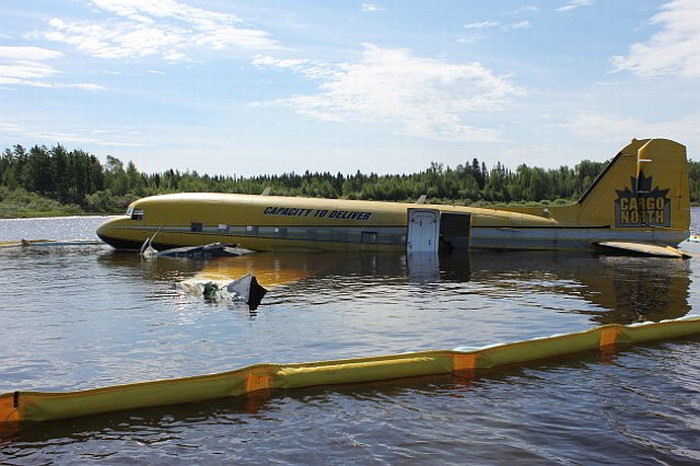Power loss of both engines on initial climb
North Star Air Ltd.
Douglas DC-3C Basler Turbo Conversions TP67, C-FKGL
Eabamet Lake, Ontario
The occurrence
On , at approximately 0140 Eastern Daylight Time, a North Star Air Ltd. Douglas DC-3C Basler Turbo Conversions TP67 aircraft (registration C-FKGL, serial number 19066) was conducting a flight from Fort Hope Airport (CYFH), Ontario, to Pickle Lake Airport (CYPL), Ontario, with 2 flight crew members on board. Shortly after takeoff, both engines (Pratt & Whitney Canada PT6A-67R) lost power simultaneously. The flight crew executed a forced landing on Eabamet Lake, Ontario. After landing, the crew evacuated the aircraft via the main cabin door and swam to shore. The Nishnawbe Aski Police Service responded and took the crew to a nursing station for treatment. Neither flight crew member was injured. The aircraft sustained substantial damage, but there was no post-impact fire. No emergency locator transmitter signal was received by the Joint Rescue Coordination Centre in Trenton, Ontario, at the time of the accident, but one was received approximately 4 hours after the accident. The accident occurred during hours of darkness.
Media materials
News release
Inadvertent movement of fuel levers lead to engine power loss in June 2019 accident on Eabamet Lake, Ontario
Read the news release
Deployment notice
TSB deploys a team of investigators following an accident near Fort Hope, Ontario, on 21 June 2019
The Transportation Safety Board of Canada (TSB) is deploying a team of investigators to examine a DC-3T aircraft recovered from Eabamet Lake, near Fort Hope, Ontario, following an accident on 21 June. The TSB will gather information and assess the occurrence.
Class of investigation
This is a class 3 investigation. These investigations analyze a small number of safety issues, and may result in recommendations. Class 3 investigations are generally completed within 450 days. For more information, see the Policy on Occurrence Classification.
TSB investigation process
There are 3 phases to a TSB investigation
- Field phase: a team of investigators examines the occurrence site and wreckage, interviews witnesses and collects pertinent information.
- Examination and analysis phase: the TSB reviews pertinent records, tests components of the wreckage in the lab, determines the sequence of events and identifies safety deficiencies. When safety deficiencies are suspected or confirmed, the TSB advises the appropriate authority without waiting until publication of the final report.
- Report phase: a confidential draft report is approved by the Board and sent to persons and corporations who are directly concerned by the report. They then have the opportunity to dispute or correct information they believe to be incorrect. The Board considers all representations before approving the final report, which is subsequently released to the public.
For more information, see our Investigation process page.
The TSB is an independent agency that investigates air, marine, pipeline, and rail transportation occurrences. Its sole aim is the advancement of transportation safety. It is not the function of the Board to assign fault or determine civil or criminal liability.
